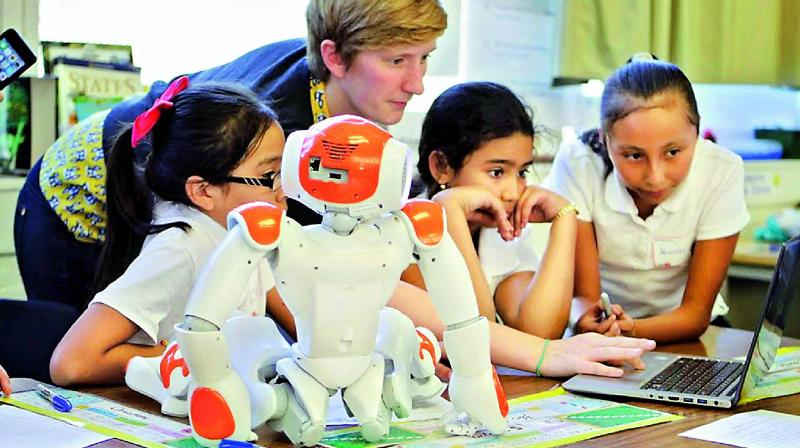Transforming Classrooms
These developments are identical to the revolution that the onset of computers once brought in.

Rote learning seems to be the bane of our education system for the last few decades. Teachers and educationalists worldwide have been trying to overcome the issue with inventive ideas, including e-learning techniques. Number of students engaged in experimental learning has surged, but will this mean robots are going to replace teachers?
While policymakers grapple on needs to tailor education systems and equip students with relevant skills, robots ironically are challenging the rote learning. Artificial Intelligence (AI), Machine Learning (ML), and Virtual Reality (VR) have come together in an impactful way to counter rote learning. They carry a real potential of transforming the traditional scenario in education.
These developments are identical to the revolution that the onset of computers once brought in. Surprisingly, these new verticals of technology have originated from these very computers.
The stakeholders of education need not worry, but instead adapt themselves to the upcoming changes brought by the highly restructured technologies of computers now present in the form of robots. These robots aren’t going to replace teachers but act as learning and teaching assistants for students and teachers respectively. Hence, the teachers and students must prepare themselves for the advent of novelty in technology, as they did in the times of incorporating computers into their professional lives.
Bridging the gap
During one of the days when I was routinely surfing the net, a news detailing about one Tyler Gibson caught my attention. Tyler, a student in his later childhood, was undergoing chemotherapy at the Children’s Cancer Hospital of UT’s MD Anderson Cancer Center. During the initial stages of Tyler’s illness, VGO, a robot powered with the capacity of Virtual Reality and Artificial Intelligence, came to his rescue. The robot helped Tyler communicate with his classmates and teachers by becoming his eyes and ears. Tyler said, “I could control VGO from home and see everything that was going on.”
“My friends would wave to me and I could wave back.” In addition to this, Tyler could also finish his assignments and send their digital versions to his teachers back in his school, despite long hours at the hospital. Clearly, robots in education evidently look to play greater roles. This might have been just one of the cases when a robot was an agent between a child and a classroom, their applications are diverse.
A helping hand to special children
Disabled students, especially ones on the autism spectrum, may find interacting with other people confusing and even intimidating. These students may struggle or sometimes completely fail to study the different expressions developing in faces of their peers and not take note of non-verbal cues. It is heartening to know that they need not face this kind of problem in the event of them having robots to initiate and maintain their conversation. The advancement in behaviourial aspects of robots promises bridging this gap in the near future. This is because, robots can be framed to resemble nearly the same as humans. Also, they will be devoid of the confounding facial expressions that divert one’s attention from what a person says. This can be clearly seen with Nao, a 23-inch-tall AI enabled robot that plays an assisting role in the education of children agonised with autism. Nao is a programmable humanoid robot developed by Aldebaran Robotics, a French robotics company headquartered in Paris. Nao helps students grasp social cues and various lessons on education while recording substantial success in the process. For instance, kids have learnt identifying different kinds of animals, by getting assisted by the robot. Similarly, older kids have learned to have a better grasp on skills pertaining to basic reading.
Acting as virtual teachers
Online classes are not uncommon anymore with technology having provided diverse platforms and services to bolster the sphere, but the groundbreaking results will come in with the help of telepresence robots. With telepresence robots enabled with the capacities of VR, to telepresent (reach far off places electronically as the television sets do) themselves anywhere, future teachers will be able to provide their lectures from anywhere in the world to even remote locations. Consequently, this extends the likelihood for learning through the distance mode. The main feature that distinguishes it from the Google Hangout sort of incident is that a distantly positioned teacher gets streamed into a tablet, which a robot in the classroom then carries it to the students.
This has fuelled the chances of having a system of tele-teachers who will provide their services in poorly connected places, deficient in educational infrastructure. Hence, the great stride of teachers reaching remote places if the students are unable to receive a teacher, can be taken in the times to come.
Stakeholders in education, leaving students, who naturally adapt to the novel changes faster, will have to focus more on devising and learning the ways to adapt to the new robots powered with revolutionary technologies of Artificial Intelligence, Machine Learning and Virtual Reality. This would in turn expand the horizons of their skill-set resulting in being more confident and qualified educationists.

